
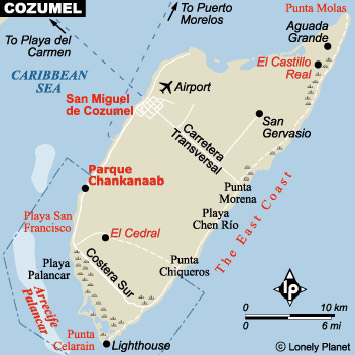 1. WHY TAKE A
FAMILY VACATION TO
COZUMEL?
1. WHY TAKE A
FAMILY VACATION TO
COZUMEL? 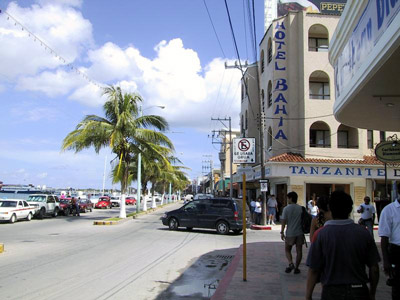 here in 1994—arrive daily disgorging thousands of
lookie-lous who clog the narrow streets, at least along the waterfront,
milling crowds in search of retail therapy. In addition to a growing
number of upscale shops and garish spots like Carlos O'Brien and Hard
Rock Cafe, we noticed a glitzy new shopping mall that rivals any mall
anywhere built very near where the big boats dock. There's money coming
off the boats and there are more and more places to leave it behind at
the end of the day. To the nearly 70,000 people who make their home on
the island, the steady stream of visitors must be physically
overwhelming as well as a financial transfusion.
here in 1994—arrive daily disgorging thousands of
lookie-lous who clog the narrow streets, at least along the waterfront,
milling crowds in search of retail therapy. In addition to a growing
number of upscale shops and garish spots like Carlos O'Brien and Hard
Rock Cafe, we noticed a glitzy new shopping mall that rivals any mall
anywhere built very near where the big boats dock. There's money coming
off the boats and there are more and more places to leave it behind at
the end of the day. To the nearly 70,000 people who make their home on
the island, the steady stream of visitors must be physically
overwhelming as well as a financial transfusion. 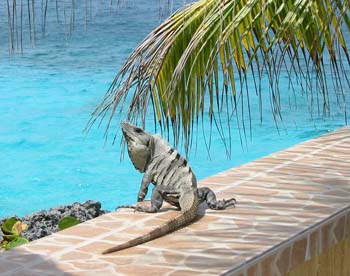 3. LAS IGUANAS:
OUR HOME AWAY FROM HOME
3. LAS IGUANAS:
OUR HOME AWAY FROM HOME 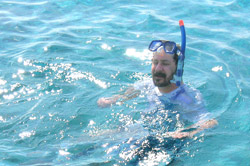 exploring for new sea creatures and coral. We also enjoyed
the salt water swimming pool, much more than
we thought we would. Dan and Hughes planned a two-tank dive along the
Palancar Reef during the week. The weather
was sensational and we got our fill.
exploring for new sea creatures and coral. We also enjoyed
the salt water swimming pool, much more than
we thought we would. Dan and Hughes planned a two-tank dive along the
Palancar Reef during the week. The weather
was sensational and we got our fill. 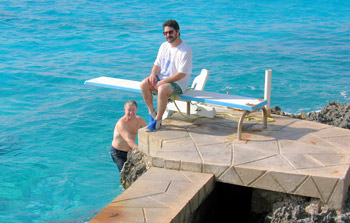 coral
face (e.g., urchins, anemones, et al.). Visibility was more
than 150 feet. Despite the regular boat traffic within 50 yards of the
shore, we saw a
wide variety of small, familiar tropicals: angels, tangs, wrasses,
ever-present schools of sergeant majors, parrotfish, jacks, rockfish,
trunkfish, balloon fish,
and many others—plus at least five varieties of eels, flounders, some
squid, a
ray, a rockfish, and a couple of small jackknife-fish and several
starfish. One group of snorkelers even reported to have seen a snake
slithering across the sand about 20 feet down.
coral
face (e.g., urchins, anemones, et al.). Visibility was more
than 150 feet. Despite the regular boat traffic within 50 yards of the
shore, we saw a
wide variety of small, familiar tropicals: angels, tangs, wrasses,
ever-present schools of sergeant majors, parrotfish, jacks, rockfish,
trunkfish, balloon fish,
and many others—plus at least five varieties of eels, flounders, some
squid, a
ray, a rockfish, and a couple of small jackknife-fish and several
starfish. One group of snorkelers even reported to have seen a snake
slithering across the sand about 20 feet down. 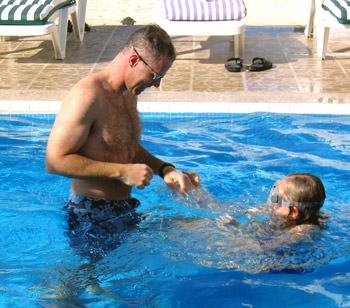 than we had anticipated. First, it
is easy to clean: sea water can be easily pumped in and drained out of
the pool. The pool maintenance folks cleaned the pool entirely twice
while we were there: draining, scrubbing, hosing down, and refilling
the pool in a few short hours. Second, while swallowing a bit of salt
water while swimming is a bit distasteful, it's safer to get in your
mouth than the city water supply: that makes most people sick. (Bottled
water was supplied throughout our stay.) We spent many hours cooling
off in the pool, as well as relaxing and reading nearby.
than we had anticipated. First, it
is easy to clean: sea water can be easily pumped in and drained out of
the pool. The pool maintenance folks cleaned the pool entirely twice
while we were there: draining, scrubbing, hosing down, and refilling
the pool in a few short hours. Second, while swallowing a bit of salt
water while swimming is a bit distasteful, it's safer to get in your
mouth than the city water supply: that makes most people sick. (Bottled
water was supplied throughout our stay.) We spent many hours cooling
off in the pool, as well as relaxing and reading nearby. 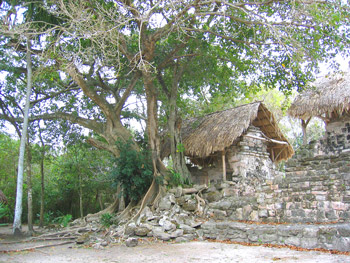 We
have been diving Belize, Cayman Islands, Cancun, Puerto Vallarta,
Hawai'i, Fiji, and the Great Barrier Reef, and can testify that diving
Cozumel is at least the equal of any. Dan and Hughes are talking about
coming back just to dive when Griffin gets his C-card.
We
have been diving Belize, Cayman Islands, Cancun, Puerto Vallarta,
Hawai'i, Fiji, and the Great Barrier Reef, and can testify that diving
Cozumel is at least the equal of any. Dan and Hughes are talking about
coming back just to dive when Griffin gets his C-card. 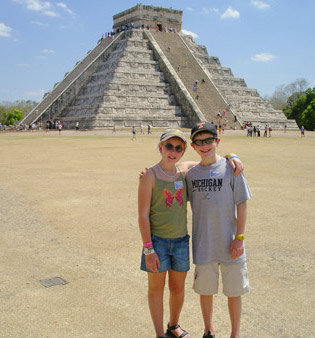 cases pile of rubble. Compared
with Chichen Itza, San Gervasio is tiny. However, it is interesting and
a peaceful diversion from the bustle of the town just 10 km away. It
was a good place for Deb, Dan, and the kids to visit before their tour
the
next day of the much more impressive…
cases pile of rubble. Compared
with Chichen Itza, San Gervasio is tiny. However, it is interesting and
a peaceful diversion from the bustle of the town just 10 km away. It
was a good place for Deb, Dan, and the kids to visit before their tour
the
next day of the much more impressive… 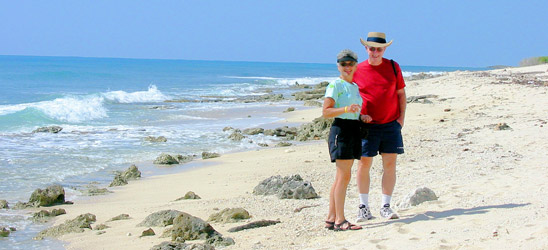 (no accommodations), but Mr. Sanchez has created
a very clean, comfortable, and attractive area for those who want a day
of sand, sun, and water toys, a place to swim, eat and drink, and watch
people. We enjoyed it more than we thought we would. Continuing north
after lunch, we passed by…
(no accommodations), but Mr. Sanchez has created
a very clean, comfortable, and attractive area for those who want a day
of sand, sun, and water toys, a place to swim, eat and drink, and watch
people. We enjoyed it more than we thought we would. Continuing north
after lunch, we passed by…  restaurants that feature fresh seafood and
other dishes cooked Mexican/Yucatan style. Yes, there are many places
that serve
enchiladas, tacos, burritos, and similar dishes more commonly
associated with Mexican food in the USA. However, to eat in a coastal
town where fish, shrimp, lobster, and calamari are caught and served
fresh daily is an opportunity to eat great seafood.
restaurants that feature fresh seafood and
other dishes cooked Mexican/Yucatan style. Yes, there are many places
that serve
enchiladas, tacos, burritos, and similar dishes more commonly
associated with Mexican food in the USA. However, to eat in a coastal
town where fish, shrimp, lobster, and calamari are caught and served
fresh daily is an opportunity to eat great seafood. 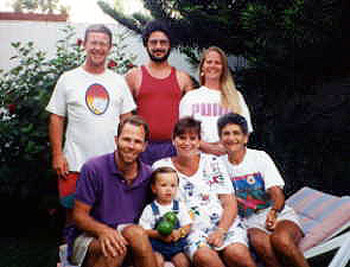 bought
a very handsome belt (made in Argentina); Judy liked it so much, she
bought a similar one for
herself. The grandchildren bought small gifts for friends and teachers
back home in addition to a small bracelet or necklace
for themselves. Cindy bought some sterling and gemstone jewelry. Dan
bought “Dive Paradise” T-shirts for Hughes and himself to remember our
day with Perfidio.
bought
a very handsome belt (made in Argentina); Judy liked it so much, she
bought a similar one for
herself. The grandchildren bought small gifts for friends and teachers
back home in addition to a small bracelet or necklace
for themselves. Cindy bought some sterling and gemstone jewelry. Dan
bought “Dive Paradise” T-shirts for Hughes and himself to remember our
day with Perfidio.  spent some time reminiscing, catching up on
who's doing what, and marveling at how capable and pleasant both
grandchildren are to have with us.
spent some time reminiscing, catching up on
who's doing what, and marveling at how capable and pleasant both
grandchildren are to have with us.  airport
to be found, we hope, by a family who needs a hand colored work of art
to grace their home.);
airport
to be found, we hope, by a family who needs a hand colored work of art
to grace their home.); 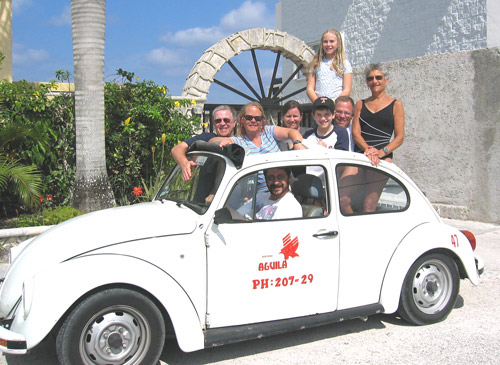 They have been too important to us in keeping
in touch with those we cherish.
They have been too important to us in keeping
in touch with those we cherish.  |
|
|